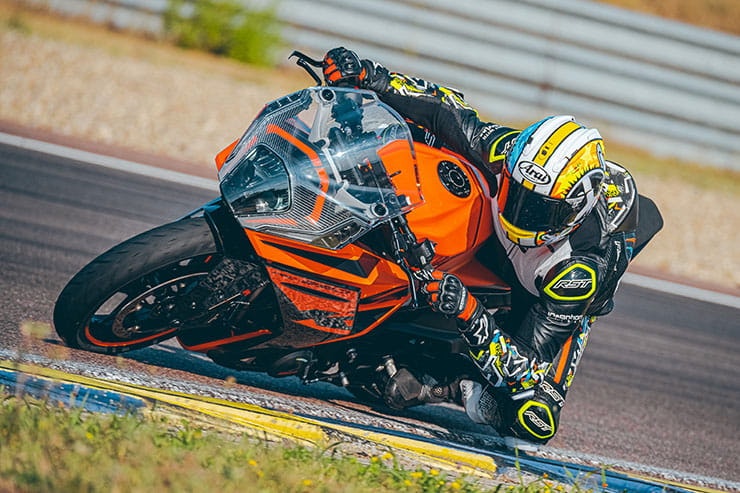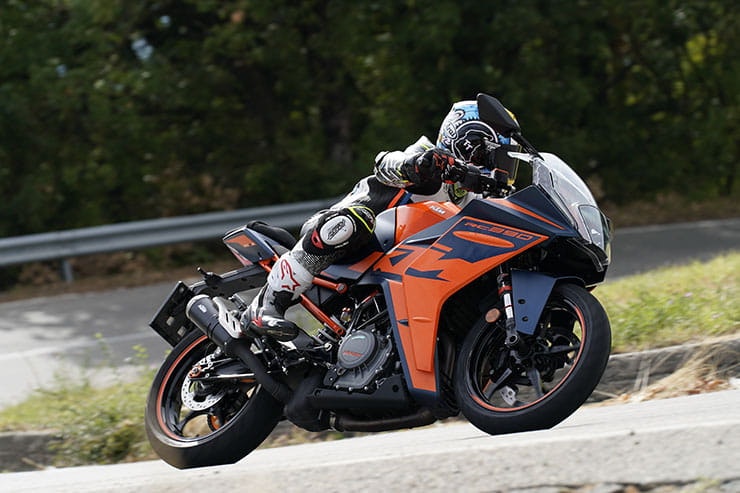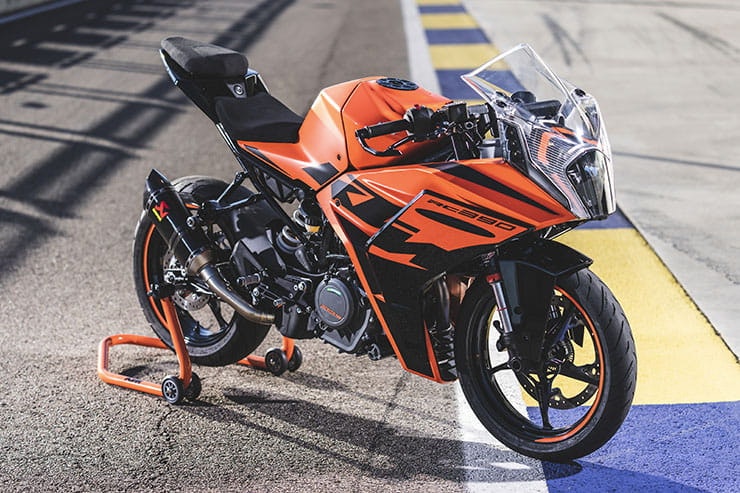KTM RC390 (2022) - Review
BikeSocial Road Tester
09.09.2021
I remember when entry level bikes were low budget and as appealing as a wet weekend in Blackpool. KTM changed that with the RC390 launched back in 2014, but now they have taken the sports A2 class to another level with the impressive 2022 RC390. Aside from the aerodynamic MotoGP inspired looks, the all-new 2022 model features a 3D IMU which supports lean sensitive rider aids – a first for this class.
To ensure the RC390 was A2 licence compliant there wasn’t a need to create more peak power. Instead, the Austrians have improved torque slightly and focused on handling, technology and aerodynamics.
The MotoGP-inspired bodywork, with its flush-fitting indicators, isn’t just dramatic. It’s also supremely aerodynamic, increasing top speed by a claimed 7kph despite no engine enhancements. Due to customer demand, the fuel tank has increased in capacity to 13.7l, up from 10l.
Most of KTM’s efforts have gone into the handling. The trellis frames is completely new with more lateral flex than the previous model, and the subframe is a separate unit that saves 1.5kg over the older bike. Suspension is provided by WP with 43mm forks featuring compression and rebound adjustment while the rear shock gets pre-load and rebound adjustment. Further weight-savings come from very trick lightweight wheels that are 3.4kg or 30% lighter than before – a huge reduction in unsprung weight.
There are new brakes and new Continental rubber, the battery and electronics have moved to between the rider and fuel tank; there’s a larger, comfier seat for rider and pillion; a new full-colour TFT dash, changeable ABS… the list just keeps going.
Class leading rider aids
Chassis and handling
Practicality
Quickshifter not standard
Engine/exhaust noise is underwhelming
Estimate price is a little top heavy
REVIEW: KTM RC390 (2022)
Riding the sprightly new KTM on the road and track is BikeSocial’s intrepid tester, Adam ‘Chad’ Child. Hear a little more about the bike, watch it in action and find out what Chad’s first impressions are.
KTM RC390 (2022) Price
How much is the KTM RC390? £5500 (estimate)
KTM hasn’t finalised prices yet because this is a 2022 bike that won’t be available until February or March next year. However, the Austrian company did confirm it will be slightly pricier than the older bike; I’d estimate £5500 to £5800.
The main competition for the RC390 comes from Yamaha’s single-cylinder R3 (£5650). The 321cc Yamaha looks great but is down on power compared to the KTM. Kawasaki's Ninja 400 is the bike to have in World SuperSport 300 and has more power and torque than the KTM, but the parallel twin engine isn’t Euro-5 compliant and is no longer listed by Kawasaki. Only preregistered bike are available, while neither the Yamaha or Kawasaki can match the tech’ and rider aids of the new RC390. We should also consider Honda’s CBR500R (£6299), while not forgetting there is an updated model from Honda due in 2022.
Power and torque
KTM hasn’t dramatically changed the single-cylinder engine, which remains at 373cc. There was little point in investing in an engine that is already on the A2 limit of 35kw/47hp. The 2022 model makes 32Kw/43bhp @ 9000rpm.
So while there was no point filling up a bath that was already full, the lightweight engine did need cleaning up to be Euro-5 compliant. This means a completely new exhaust, revised fuelling, and a 40% larger airbox, which has boosted torque slightly, up 2Nm to 37Nm @ 7000rpm.
Despite the engine remaining relatively untouched, top speed has increased due to the improved aerodynamic efficiency of new bodywork, which was inspired by the RC16 race-wining bike MotoGP bike.
Engine, gearbox and exhaust
A quick press of the starter button and, to be honest, I’m a little disappointed. It sounds strangled in stock trim. On the track part of this test, KTM fitted the optional Akrapovic muffler, which added a little more pep, but in Euro-5 road trim it’s a little underwhelming.
Once higher up in the rev range the backing vocals do improve and this is where you’ll want to spend most of the time, should you want to make full use of the RC390’s new sporting potential.
Don’t get me wrong, below 6000rpm the single-cylinder will pull easily and cleanly, with only a slight ‘chug’ below 2000rpm, and is nothing like the ditch-pump single-cylinder engines of old. The revised fuelling is clean, not aggressive, and ideal for less experienced riders – this is a useable and refined single-cylinder engine. For maximum entertainment you need to be north of 6000rpm or 7000rpm, especially on track.
At 75-80mph the rev counter hovers around 7000rpm or a little more depending on the conditions and the rider. There are still plenty of revs to play with, and the RC will happily pull to the redline in each gear – even top. I managed to squeeze out an indicated 111mph; tucked in with a favourable tailwind there might be a little more before you hit the rev limiter.
On road or on track the Austrian motor loves being thrashed: nudge the optional quickshifter when the full colour digital rev counter starts to flash then it’s elbows in, head down and try to extract every last horsepower. Ok, you don’t have a huge amount of power to play with, but it feels like more. The RC is pure and uncomplicated fun to ride fast – especially as you’re not doubling the national speed limit and in instant ban territory every time you open the throttle. It’s worth remembering, too, that those who turn their noses up at a 43bhp output should remember that that is a similar amount to Yamaha's legendary 350LC, which was – and for many remains – the embodiment of lightweight fun.
And once on the apex you can get on the power so much earlier than on a full-fat superbike, which is basically down to three reasons. 1 - you don’t have that much power, so you don’t have to wait as you would if you had 200bhp on tap. 2 - the Continental rubber combined with excellent mechanical grip and feedback is reassuring. 3 - should you get a little carried away – easily done on track – then you have lean sensitive traction control as a backup.
Handling, suspension and weight
This is where KTM has focused its efforts – and it shows. As you’d expect, WP controls the suspension at each end: 43mm USD forks up front with 30 clicks of compression on the left leg and 30 clicks of rebound on the right. The rear shock has pre-load and rebound damping, which can be changed via the tools under the seat.
Wheels are new and very light, saving 3.4kg – a massive reduction in unsprung weight. The trellis frame is new, too, and similar to that of the 390 Duke but with more flex to give the rider more feel, and now attaches to a removable subframe.
The fuel tank has moved and increased in size, and the battery now sits between the rider and fuel tank. Quoted weight is 155kg ‘ready to race’ but with no fuel. The quoted dry weight of the old bike was less, but you are not comparing apples with apples, as the new bike is Euro-5 compliant with more advanced rider aids. Wheels, frame and even the brakes are lighter on the new model.
You are immediately aware of the bike’s lightness and agility. Around the congested streets of Modena in Northern Italy, the 390 felt lively, darting between cars and over roundabouts with minimal input, like a happy puppy chasing a stick though with more regard to danger. A new rider will thrive in its ease of use and natural control.
With the urban congestion dealt with it was up into the mountain passes where the RC390 continued to shine. The suspension feels high quality and plush, though possibly a little soft on the rear. It’s forgiving, creating a smooth unintimidating ride quite unlike the hard race bike image the KTM marketing proclaims, but the feedback is excellent while the Continental rubber gives excellent grip to knee-down levels of lean.
As the pace hotted up, I found the rear a little too soft, possibly set up for someone lighter (I’m 12 stone 6). However, after a slight adjustment of pre-load and rebound, which took a minute at the side of the road, I was happy and back into the swing of things. The small adjustments were immediately apparent which highlights the quality of suspension, something you don’t normally find on a ‘budget’ bike.
You can ride the RC390 hard on the track, it’s more than capable and again the quality components rise to the occasion. I was pushing for fast lap times, yet the suspension (still on my personal settings) remained controlled, ground clearance was fine, and the brakes didn’t fade. I was slightly concerned the Continental tyres might not be up for the challenge, but I was wrong. They only started to drop off slightly towards the end of a long 20-minute session in 30-degree heat, which is to be expected for any road tyre.
After six fast track sessions I had to remind myself that this is an entry-level bike, built to a budget and designed to be a doddle to ride at low speeds – because on track it more than delivered. Ok, there’s a relative dearth of power and the track was tight, but it was still a buzz dancing on the optional quickshifter. The long track sessions highlighted how good the major components of the RC390 are. I’m unsure why I should be surprised by how well the RC worked on track – after all, KTM is now winning races in MotoGP as well as Moto 2 and Moto 3.
Above: RC390 on track is so rewarding
Comfort and economy
KTM has listened to customer feedback and knew they had to improve the tank range of the RC390. Now fuel capacity has gone up from 10l to 13.7l, which gives the KTM a theoretical tank range of 250 miles.
That might sound ludicrous, but even after a hard day’s riding on the road, the RC390 returned just under the quoted 83mpg, recording 78mpg. I’d estimate that, ridden with a little more respect, it would easily deliver over 80mpg.
Riding 250 miles on a A2 licenced ‘entry-level’ bike may seem as appealing a poke in the eye, but comfort is surprisingly good. The seat for both rider and pillion is larger, the bodywork is a decent size; it’s not toy-like, like some bikes in this category. Both levers and even the bars can be adjusted to suit all riders.
As mentioned, the RC is happy cruising at 70mph, where it’s a little buzzy but nothing untoward.
The all-new full colour dash, with Bluetooth connectivity, is relatively simple to navigate, with no multiple riding modes to add into the mix. It’s easy to scroll through the trips and relevant information as well as clear and easy to read. You can even turn off the TC on the move. I’d take on some serious miles on the KTM, but I’m unconvinced about the pillion perch...
Brakes
Stopping power has been increased courtesy of a radial mounted ByBre four-piston calliper grabbing a 320mm single brake disc, with a 230mm disc on the rear, and the new set up is also lighter by 960g.
The lever (like the clutch) is span adjustable and cornering ABS is standard. There is also the option to switch into Supermoto mode, which allows the rear to lock, but still maintains ABS on the front. This allows you to brake devilishly late, even with the rear off the ground there is no ABS interventional until the front locks.
On the road, the new ByBre brakes have a one finger operation, not grabby with a nice feel. On the track, in Supermoto mode, stopping requires a few more fingers on the lever, but their power is still impressive. Even after a heavy track session, there was no fade. Ok, they are only stopping 155kg of motorcycle but add my 79kg and fuel and that’s nearly 250kg – a lot of abuse for a single disc – and the ABS intervention was exceptional.
Rider aids, extra equipment and accessories
As noted, the RC390 comes equipped with lean sensitive ABS and Mid-corner Traction Control (MTC). KTM uses a 3D sensor to work out what the bike is doing instead of a sophisticated (and pricey) 6-axis IMU, which you would find on a £20,000 superbike or adventure bike, but it works in a similar way just using fewer sensors.
The lean sensitive ABS is excellent, the rider only feeling the rear ABS kick in on the road on uneven ground. And I never needed to rely on the traction control, not even on track in perfect conditions.
You could argue TC is unnecessary on an A2 machine but I believe new riders will be attracted to the RC390 because it has lean sensitive rider aids as standard. It’s a friendly backup should you get a little too carried away. We rode in perfect conditions, but at night, in town and coping with spilt diesel and blind taxi drivers, I’d certainly want that reassurance of TC.
As you’d expect from KTM there is a full list of Powerparts, including the race muffler fitted to our track bike. There are also racing chains, brake guards, paddock stands… everything you should need for a track day. Luggage accessories haven’t been confirmed yet as it’s a 2022 model but KTM usually provide enough kit for touring.
Rivals
KTM RC390 (2022) Verdict
The now old RC390 was a very capable bike and when launched was a mild revelation. But it was beginning to look and feel dated, desperately in need of a touch-up, but KTM has gone to another level with the all-new RC390, it really does set a new benchmark for this class in its handling, chassis spec and electronic rider aids.
Ok, it only has 43bhp but is punching way above its weight. Light and nimble around town, it can also cut it on track and has impressive comfort and range for this class. MotoGP-inspired looks, TFT clocks, WP suspension and LED lights add to its appeal, while even the bodywork is easy to remove should you want to go racing.
The new RC390 is a big step up over the old model and has set a high benchmark for this class. If you want a sporty A2 bike then look no further. The only downside is the price hasn’t been confirmed yet, and it could be relatively pricy, and the quickshifter isn’t standard.
KTM RC390 (2022) Technical Specification
What is MCIA Secured?
MCIA Secured gives bike buyers the chance to see just how much work a manufacturer has put into making their new investment as resistant to theft as possible.
As we all know, the more security you use, the less chance there is of your bike being stolen. In fact, based on research by Bennetts, using a disc lock makes your machine three times less likely to be stolen, while heavy duty kit can make it less likely to be stolen than a car. For reviews of the best security products, click here.
MCIA Secured gives motorcycles a rating out of five stars, based on the following being fitted to a new bike as standard:
A steering lock that meets the UNECE 62 standard
An ignition immobiliser system
A vehicle marking system
An alarm system
A vehicle tracking system with subscription
The higher the star rating, the better the security, so always ask your dealer what rating your bike has, and compare it to other machines on your shortlist.


